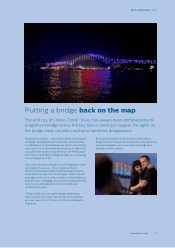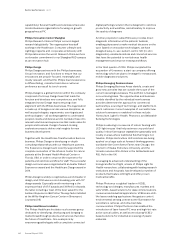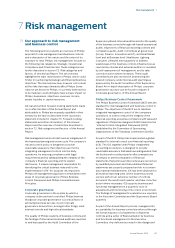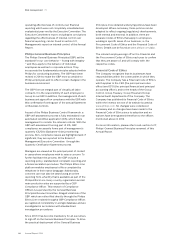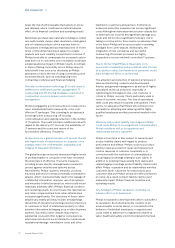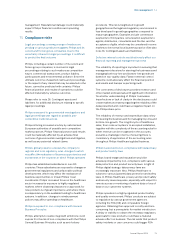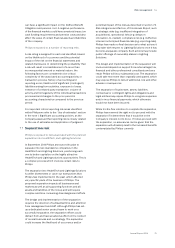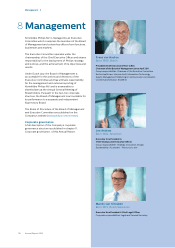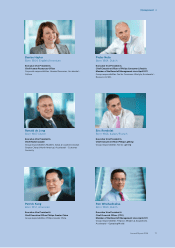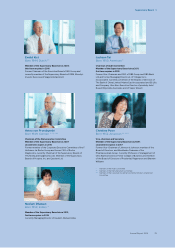Philips 2014 Annual Report Download - page 70
Download and view the complete annual report
Please find page 70 of the 2014 Philips annual report below. You can navigate through the pages in the report by either clicking on the pages listed below, or by using the keyword search tool below to find specific information within the annual report.Risk management 7.3
70 Annual Report 2014
The very disparate macroeconomic outlook for the
main geographies, political conicts and the unknown
potential impact of new initiatives in Eurozone
monetary policy continues to provide uncertainty on
the levels of capital expenditures in general,
unemployment levels and consumer and business
condence, which could adversely aect demand for
products and services oered by Philips.
General political developments in 2014 were
unfavorable for the business environment due to
increasing political conicts and terrorism, e.g. the
nancial/economic sanctions imposed on Russia and
the response from the Russian government. Numerous
other factors, such as sustained lower levels of energy
and raw material prices, as well as global political
conicts in the Middle East, Russia and Ukraine and
other regions, could continue to impact
macroeconomic factors and the international capital
and credit markets. Economic and political uncertainty
may have a material adverse impact on Philips’ nancial
condition or results of operations and can also make it
more dicult for Philips to budget and forecast
accurately. Philips may encounter diculty in planning
and managing operations due to the lack of adequate
infrastructure and unfavorable political factors,
including unexpected legal or regulatory changes such
as foreign exchange import or export controls,
increased healthcare regulation, nationalization of
assets or restrictions on the repatriation of returns from
foreign investments. Given that growth geographies are
becoming increasingly important in Philips’ operations,
the above-mentioned risks are also expected to grow
and could have a material adverse eect on Philips’
nancial condition and operating results.
Philips may be unable to adapt swiftly to changes in
industry or market circumstances, which could have a
material adverse impact on its nancial condition and
results.
Fundamental shifts in the industry, like the transition
from traditional lighting to LED lighting, may drastically
change the business environment. If Philips is unable to
recognize these changes in good time, is late in
adjusting its business models, or if circumstances arise
such as pricing actions by competitors, then this could
have a material adverse eect on Philips’ growth
ambitions, nancial condition and operating result.
Philips’ overall performance in the coming years is
dependent on realizing its growth ambitions in growth
geographies.
Growth geographies are becoming increasingly
important in the global market. In addition, Asia is an
important production, sourcing and design center for
Philips. Philips faces strong competition to attract the
best talent in tight labor markets and intense
competition from local companies as well as other
global players for market share in growth geographies.
Philips needs to maintain and grow its position in
growth geographies, invest in local talents, understand
developments in end-user preferences and localize the
portfolio in order to stay competitive. If Philips fails to
achieve this, then this could have a material adverse
eect on growth ambitions, nancial condition and
operating result.
The growth ambitions of Philips may be adversely
aected by economic volatility inherent in growth
geographies and the impact of changes in
macroeconomic circumstances on growth economies.
Philips may not control joint ventures or associated
companies in which it invests, which could limit the
ability of Philips to identify and manage risks.
Philips has invested or will invest in joint ventures or
associated companies in which Philips will have a non-
controlling interest. In these cases, Philips has limited
inuence over, and limited or no control of, the
governance, performance and cost of operations of
joint ventures or associated companies. Some of these
joint ventures or associated companies may represent
signicant investments. The joint ventures and
associated companies that Philips does not control
may make business, nancial or investment decisions
contrary to Philips’ interests or decisions dierent from
those, which Philips itself may have made. Additionally,
Philips partners or members of a joint venture or
associated company may not be able to meet their
nancial or other obligations, which could expose
Philips to additional nancial or other obligations, as
well as have a material adverse eect on the value of its
investments in those entities or potentially subject
Philips to additional claims.
Acquisitions could expose Philips to integration risks
and challenge management in continuing to reduce the
complexity of the company.
Philips’ acquisitions may continue to expose Philips in
the future to integration risks in areas such as sales and
service force integration, logistics, regulatory
compliance, information technology and nance.
Integration diculties and complexity may adversely
impact the realization of an increased contribution from
acquisitions. Philips may incur signicant acquisition,
administrative and other costs in connection with these
transactions, including costs related to the integration
of acquired businesses.
Furthermore, organizational simplication and
resulting cost savings may be dicult to achieve.
Acquisitions may also lead to a substantial increase in
long-lived assets, including goodwill. Write-downs of
these assets due to unforeseen business developments
may have a material adverse eect on Philips’ earnings,
particularly in Healthcare and Lighting, which have
signicant amounts of goodwill (see also note 11,
Goodwill).



